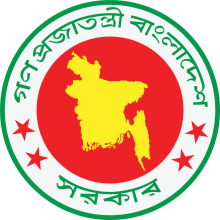Dhaka
Dhaka (/ˈdɑːkə/ DAH-kə or /ˈdækə/ DAK-ə; , pronounced [ˈɖʱaka]), formerly known as Dacca,[8] is the capital and the largest city of Bangladesh. It is the ninth-largest,[9] and the sixth-most densely populated city in the world,[7][10] with a population of 8.9 million residents within the city limits,[11] and a population of over 21 million residents in the Greater Dhaka Area.[12][13] Dhaka is the economic, political and cultural center of Bangladesh. It is one of the major cities of South Asia, the largest city in Eastern South Asia and among the Bay of Bengal countries; and one of the largest cities among OIC countries. As part of the Bengal plain, the city is bounded by the Buriganga River, Turag River, Dhaleshwari River and Shitalakshya River. The city is located in an eponymous district and division.
Dhaka ঢাকা Dacca | |
|---|---|
.jpg) .jpg)  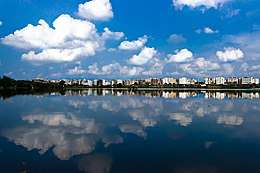 From top: View of Paltan Sangsad Bhaban in Sher-e-Bangla Nagar, Illuminated Hatirjheel lakefront, Curzon Hall at University of Dhaka, Lalbagh Fort in Old Dhaka, Uttara Lake in City North | |
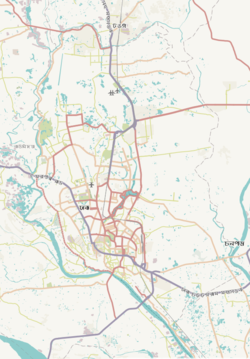 Dhaka Location of Dhaka in Dhaka Division, Bangladesh 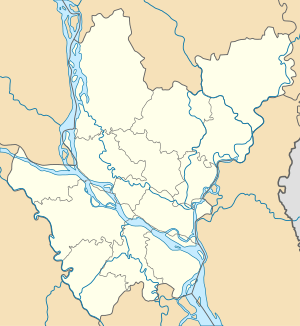 Dhaka Dhaka (Dhaka division)  Dhaka Dhaka (Bangladesh) 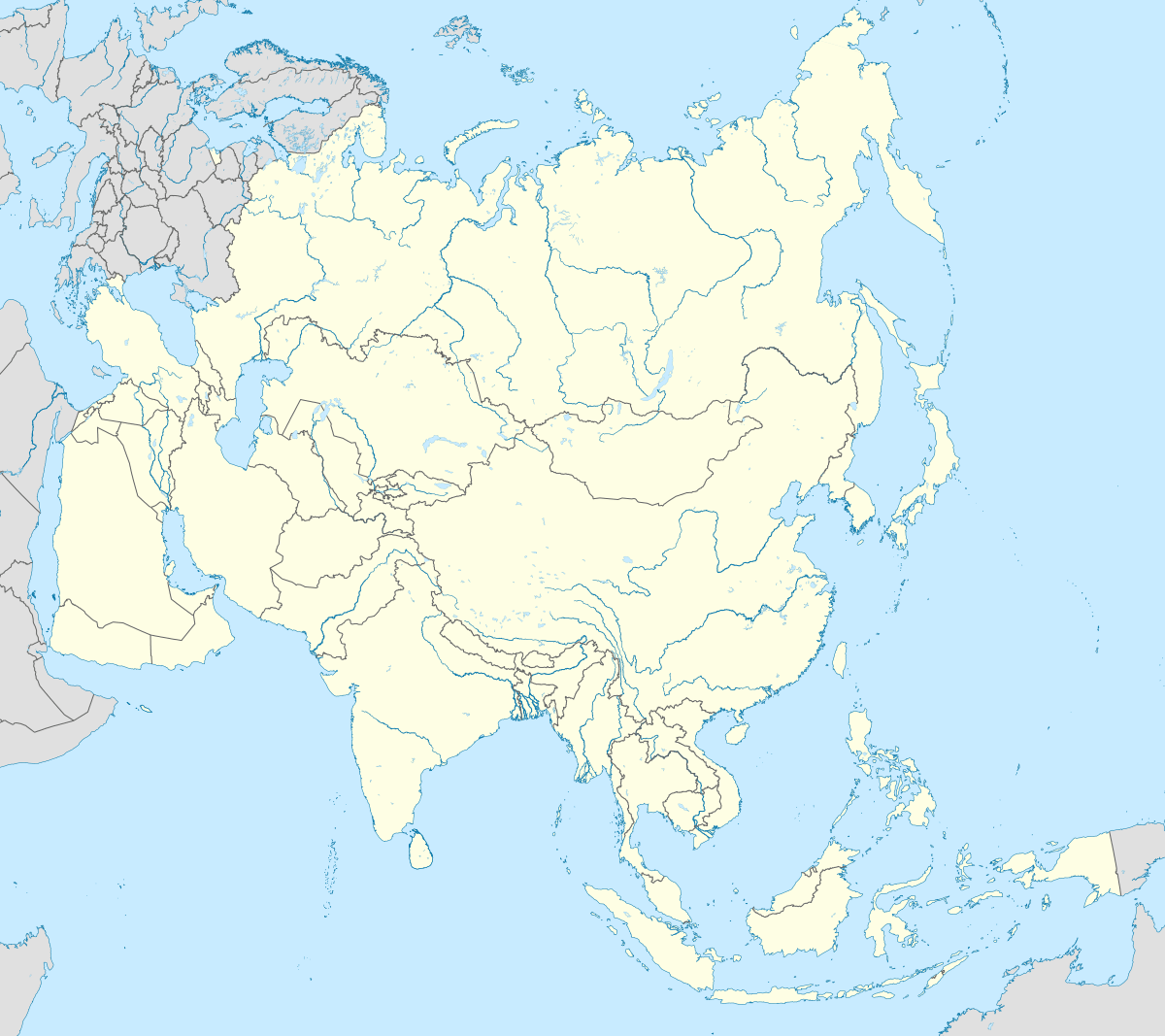 Dhaka Dhaka (Asia) .svg.png) Dhaka Dhaka (Earth) | |
| Coordinates: 23°45′50″N 90°23′20″E | |
| Country | |
| Division | Dhaka Division |
| District | Dhaka District |
| Establishment | 1608 CE |
| Granted city status | 1947 |
| Government | |
| • Type | Mayor - Councilor |
| • Body | DNCC and DSCC |
| • North City Mayor | Atiqul Islam[1] |
| • South City Mayor | Sheikh Fazle Noor Taposh[1] |
| Area | |
| • Urban | 306 km2 (118 sq mi) |
| • Metro | 2,161.17[4] km2 (834.432[4] sq mi) |
| Elevation | 4 m (13.12 ft) |
| Population | |
| • Capital city | 8,906,039 |
| • Rank | 1st |
| • Density | 46,997/km2 (121,720/sq mi) |
| • Metro | 21,006,000 |
| Demonym(s) | Dhakaite, Dhakaiya |
| Time zone | UTC+6 (BST) |
| Postal code | 1000, 1100, 12xx, 13xx |
| National calling code | +880 |
| Calling code | 02 [For Dhaka city only] |
| Police | Dhaka Metropolitan Police |
| International airport | Hazrat Shahjalal International Airport |
| ISO 3166-2 | BD-13 |
| Website | Dhaka North City Corporation Dhaka South City Corporation |
The area of Dhaka has been inhabited since the first millennium. The city rose to prominence in the 17th century as a provincial capital and commercial center of the Mughal Empire in South Asia. Dhaka was the capital of the proto-industrialised Mughal Bengal for 75 years(1608–39 and 1660–1704). As the center of the muslin trade in Bengal, it was one of the most prosperous cities in the Indian subcontinent. The medieval city was named Jahangirabad in honor of the Mughal Emperor Jahangir and hosted the seat of the Mughal Subahdar, Naib Nazims and Dewans. Medieval Dhaka's glory peaked in the 17th and 18th centuries, when it was home to merchants from across Eurasia. It was the centre of a flourishing se trade attracting English, French, Armenian, Portuguese, and Dutch traders. The Mughals decorated the city with well-laid out gardens, tombs, mosques, palaces and forts. The city was once called the Venice of the East.[14] Under the British Empire, the city saw the introduction of electricity, railways, cinemas, Western-style universities and colleges and a modern water supply. It became an important administrative and educational center in Eastern Bengal and Assam after 1905.[15] In 1947, after the end of British rule, it became the administrative capital of East Pakistan. It was declared as the legislative capital of Pakistan in 1962. In 1971, it became the capital of an independent Bangladesh. Article 5 of the Constitution of Bangladesh declares Dhaka as the capital of the republic.[16]
Dhaka is the financial, commercial and the entertainment capital of Bangladesh. It accounts for up to 35% of Bangladesh's economy.[17] Since its establishment as a modern capital city the population, area, social and economic diversity of Dhaka have grown tremendously. Dhaka is now one of the most densely industrialized regions in the country.[18] Dhaka is a major international City, as it host the headquarters of Several International cooperations. By the 21st century, it emerged as a megacity, which is now listed as a beta-global city by the Globalization and World Cities Research Network (GaWC). The Dhaka Stock Exchange has over 750 listed companies. The city hosts over 50 diplomatic missions and the headquarters of BIMSTEC. The city's culture is known for its cycle-rickshaws, cuisine, art festivals and religious diversity. The old city is home to around 2000 buildings from the Mughal and British periods, including notable structures such as the Bara Katra and Choto Katra caravansaries.
Etymology
The origins of the name for Dhaka are uncertain. Once dhak trees were very common in the area and the name may have originated from it. Alternatively, this name may refer to the hidden goddess Dhakeshwari, whose temple is located in the south-western part of the city.[19] Another popular theory states that Dhaka refers to a membranophone instrument, dhak which was played by order of Subahdar Islam Khan I during the inaugurating of the Bengal capital in 1610.[20]
Some references also say it was derived from a Prakrit dialect called Dhaka Bhasa; or Dhakka, used in the Rajtarangini for a watch-station; or it is the same as Davaka, mentioned in the Allahabad pillar inscription of Samudragupta as an eastern frontier kingdom.[21] According to Rajatarangini written by a Kashmiri Brahman, Kalhana,[22] the region was originally known as Dhakka. The word Dhakka means watchtower. Bikrampur and Sonargaon—the earlier strongholds of Bengal rulers were situated nearby. So Dhaka was most likely used as the watchtower for the fortification purpose.[22]
History
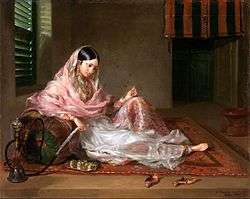
The history of urban settlement in the area of modern-day Dhaka dates to the first millennium.[19] The region was part of the ancient district of Bikrampur, which was ruled by the Sena dynasty.[23] Under Islamic rule, it became part of the historic district of Sonargaon, the regional administrative hub of the Delhi and the Bengal Sultanates.[24] The Grand Trunk Road passed through the region, connecting it with North India, Central Asia and the southeastern port city of Chittagong.
The Mughal Empire governed the region during the early modern period. Under Mughal rule, the Old City of Dhaka grew on the banks of the Buriganga River. Dhaka was proclaimed the capital of Mughal Bengal in 1608. Islam Khan Chishti was the first administrator of the city.[25] Khan named it "Jahangirabad" (City of Jahangir) in honour of the Emperor Jahangir. The name was dropped soon after the English conquered. The main expansion of the city took place under Mughal governor Shaista Khan. The city then measured 19 by 13 kilometres (11.8 by 8.1 mi), with a population of nearly one million.[26] Dhaka was one of the largest and most prosperous cities in South Asia.[27] It grew into a regional economic center during the 17th and 18th centuries, serving as a hub for Eurasian traders, including Bengalis, Marwaris, Kashmiris, Gujaratis, Armenians, Arabs, Persians, Greeks, Dutch, French, English, and the Portuguese.[24][28][29] The city was a center of the worldwide muslin, cotton and jute industries, with 80,000 skilled weavers.[30] Mughal Bengal generated 50% of the Mughal Empire's GDP, which at the time constituted 29% of world GDP. Dhaka was the commercial capital of the empire.[30] The city had well-laid out gardens, monuments, mosques, temples, bazars, churches and caravansaries. The Bara Katra was the largest caravansary. The riverbanks were dotted with tea houses and numerous stately mansions. Eurasian traders built neighborhoods in Farashganj (French Bazaar), Armanitola (Armenian Quarter) and Postogola (Portuguese Quarter).
Bengal was an affluent region in the Mughal era. According to economic historian Indrajit Ray, it was globally prominent in industries such as textile manufacturing and shipbuilding.[31] It was an exporter of silk and cotton textiles, steel, saltpeter, and agricultural and industrial produce.[30]
With the defeat of the Nawab of Bengal at the Battle of Buxar in 1764, the British East India Company gained the right to collect taxes from the principality of Bengal. The city formally passed to the control of the British East India Company in 1793 and Dhaka got plugged into the imperial mercantile networks of the British Empire.[32] With the dawn of the Industrial Revolution in Great Britain, Dhaka became a leading center of the jute trade, as Bengal accounted for the largest share of the world's jute production.[33]
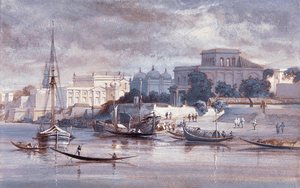
Dhaka suffered stagnation and decline began during the mid 19th-century. Its muslin industry was destroyed by high colonial taxation, restriction of trade and forced imports of British manufactured textiles. The city's weavers starved to death during Bengal famines.[30] The rise of the colonial capital Calcutta caused a sharp decline in the city's population. Dhaka became heavily impoverished. In 1824, an Anglican bishop described Dhaka as a city of magnificent ruins.[34] During the mutiny of 1857, the city witnessed revolts by the Bengal Army.[35] The British Indian rule was established following the mutiny. It bestowed privileges on the Dhaka Nawab Family, which dominated the city's political and social elite. The Dhaka Cantonment was established as a base for the British Indian Army. The British developed the modern city around Ramna, Shahbag Garden and Victoria Park. A modern civic water system was introduced in 1874.[36] In 1885, the Dhaka State Railway was opened with a 144 km metre gauge (1000 mm) rail line connecting Mymensingh and the Port of Narayanganj through Dhaka.[37] The city later became a hub of the Eastern Bengal State Railway.[37] The first cinema was shown in Dhaka's riverfront Crown Theatre on 17 April 1898.[38] The film show was organized by the Bedford Bioscope Company.[38] The electricity supply began in 1901.[39]
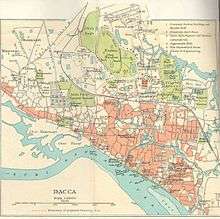
Some of the early educational institutions established during the British period include the Dhaka College, the Dhaka Medical School, the Eden College, St. Gregory's School, the Mohsinia Madrasa, Jagannath College and the Ahsanullah School of Engineering. Horse racing was a favorite pastime for elite residents in the city's Ramna Race Course beside the Dhaka Club. The Viceroy of India would often dine and entertain with Bengali aristocrats in the city. Automobiles began appearing after the turn of the century.
By the early-20th century, Dhaka projected itself as the standard bearer of Muslim minorities in British India; as opposed to the heavily Hindu-dominated city of Calcutta.[33] During the abortive Partition of Bengal in 1905, Dhaka became the short lived capital of Eastern Bengal and Assam. In 1906, the All India Muslim League was formed at the Ahsan Manzil, during a conference on liberal education hosted by Nawab Sir Khawja Salimullah. Bengal was reunited in 1911. The University of Dhaka was established in 1921 by an Act passed in the Imperial Legislative Council. It started with 3 faculties and 12 departments, covering the subjects of Sanskrit, Bengali, English, Education, History, Arabic, Islamic Studies, Persian, Urdu, Philosophy, Economics, Politics, Physics, Chemistry, Mathematics, and Law.
The East Bengal Cinematograph Company produced the first full-length silent movies in Dhaka during the 1920s, including Sukumari and The Last Kiss.[38] DEVCO, a subsidiary of the Occtavian Steel Company, began wide scale power distribution in 1930.[39] The Tejgaon Airport was constructed during World War II as a base for Allied Forces. The Dhaka Medical College was established in 1946.
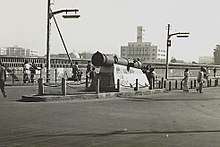
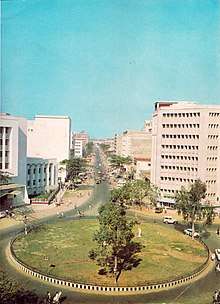
With the Partition of British India in 1947, Dhaka became the capital of East Bengal (1947-1955) and East Pakistan (1955-1971). It hosted the largest legislature in Pakistan, as East Bengalis compromised the majority of the new state's population. Dhaka's urban population increased dramatically because of Muslim migration from across Bengal and other parts of the subcontinent.[40] Dhaka began to see rapid urban expansion from the 1950s. The East Pakistan Stock Exchange Association was formed on 28 April 1954 and later became the Dhaka Stock Exchange. Orient Airways, founded by the East Pakistani industrialist Mirza Ahmad Ispahani, began the first commercial flight between Dhaka and Karachi on 6 June 1954. The airline later evolved into Pakistan International Airlines. The Dhaka Improvement Trust was established in 1956 to coordinate the city's development. The first master plan for the city was drawn up in 1959.[41] Several countries opened consulates in Dhaka, including the United States, India, the United Kingdom, the Soviet Union and the People's Republic of China. The Southeast Asia Treaty Organization established a research center (now called ICDDR,B) for combating disease in 1960.
As early as 1947, there were demands for Dhaka to host the parliament of the federation of Pakistan. Shaista Suhrawardy Ikramullah stated that the country's Constituent Assembly should meet in East Bengal due to the region's large population. In 1962, President Ayub Khan designated Dhaka as the seat of the proposed National Assembly outlined in the 1962 Constitution. The government appointed Louis Kahn and Muzharul Islam to design a capitol complex in Dhaka. The city was declared as the country's legislative capital.[42] The Inter-Continental Hotel of Dhaka, designed by William B. Tabler, opened in 1966 in Ramna. The East Pakistan Helicopter Service connected Dhaka with other regional cities as part of the largest commercial helicopter network in the world.
The Awami League was formed at the Rose Garden Palace, in 1949 as the Bengali alternative to the domination of the Muslim League in Pakistan. Growing political, cultural and economic rifts emerged between the two wings of the country. The Bengali Language Movement reached its peak in 1952.[43] Dhaka remained a center of revolutionary and political activity, as student activism and demands for autonomy increased. The Six point movement in 1966 was widely supported by the city's residents. The city had an influential press with prominent newspapers like the Ittefaq and the Weekly Holiday. During the political and constitutional crisis in 1971, the military junta led by Yahya Khan refused to transfer power to the newly elected National Assembly, causing mass riots, civil disobedience and a movement for self-determination. On 7 March 1971, Awami League leader Sheikh Mujibur Rahman addressed a massive public gathering at the Ramna Race Course Maidan in Dhaka, in which he warned of an independence struggle.[44][45] Subsequently, East Pakistan came under a non-co-operation movement against the Pakistani state. On Pakistan's Republic Day (23 March 1971), Bangladeshi flags were hoisted throughout Dhaka in a show of resistance.[46]
On 25 March 1971, the Pakistan Army launched military operations under Operation Searchlight against the population of East Pakistan.[47] Dhaka bore the brunt of the army's atrocities, witnessing a genocide and a campaign of wide scale repression, with the arrest, torture and murder of the city's civilians, students, intelligentsia, political activists and religious minorities. The army faced mutinies from the East Pakistan Rifles and the Bengali police.[48] Large parts of the city were burnt and destroyed, including Hindu neighborhoods.[47] Much of the city's population was either displaced or forced to flee to the countryside.[49] In the ensuing Bangladesh War of Independence, the Bangladesh Forces launched regular guerrilla attacks and ambush operations against Pakistani forces. Dhaka was struck with numerous air raids by the Indian Air Force in December.[50] Dhaka witnessed the surrender of the west Pakistan forces in front of the Bangladesh-India Allied Forces on 16 December 1971 with the surrender of Pakistan.[51]
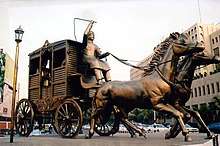
Dhaka was declared the national capital by the Constituent Assembly of Bangladesh in 1972. The post-independence period witnessed rapid growth as Dhaka attracted migrant workers from across rural Bangladesh. 60% of population growth has been due to rural migration.[52] The city endured socialist unrest in the early 1970s, followed by a few years of martial law. The stock exchange and free market were restored in the late 1970s. In the 1980s, Dhaka saw the inauguration of the National Parliament House (which won the Aga Khan Award for Architecture), a new international airport and the Bangladesh National Museum. Bangladesh pioneered the formation of the South Asian Association for Regional Cooperation (SAARC) and hosted its first summit in Dhaka in 1985.[53] A mass uprising in 1990 led to the return of parliamentary democracy. Dhaka has hosted a trilateral summit between India, Pakistan and Bangladesh in 1998;[54] the summit of the D-8 Organization for Economic Cooperation in 1999 and conferences of the Commonwealth, SAARC, the OIC and United Nations agencies during various years.
In the 1990s and 2000s, Dhaka experienced improved economic growth and the emergence of affluent business districts and satellite towns.[55] Between 1990 and 2005, the city's population doubled from 6 million to 12 million.[56] There has been increased foreign investment in the city, particularly in the financial and textile manufacturing sectors. But frequent hartals by political parties have greatly hampered the city's economy.[57] The hartal rate has declined since 2014. In some years, the city experienced a widespread flash flood during the monsoon.
Dhaka is one of the fastest growing megacities in the world.[58] It is predicted to be one of the world's largest metropolises by 2025, along with Tokyo, Mexico City, Shanghai, Beijing and New York City.[59] Dhaka remains one of the poorest megacities. Most of its population are rural migrants, including climate refugees.[60] Blue-collar workers are often housed in slums. Congestion is one of the most prominent features of modern Dhaka. In 2014, it was reported that only 7% of the city was covered by roads.[61] The first phase of the Dhaka Metro is planned for opening in 2021, coinciding with the golden jubilee of Bangladesh's independence.
Geography
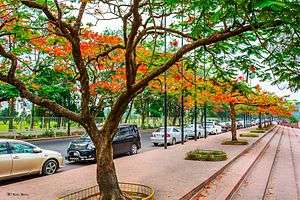
Topography
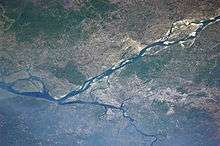
Dhaka is located in central Bangladesh at 23°42′N 90°22′E, on the eastern banks of the Buriganga River. The city lies on the lower reaches of the Ganges Delta and covers a total area of 306.38 square kilometres (118.29 sq mi). Tropical vegetation and moist soils characterize the land, which is flat and close to sea level. This leaves Dhaka susceptible to flooding during the monsoon seasons owing to heavy rainfall and cyclones.[62] Dhaka District is bounded by the districts of Gazipur, Tangail, Munshiganj, Rajbari, Narayanganj, Manikganj.
Climate
Under the Köppen climate classification, Dhaka has a tropical savanna climate (Köppen Aw). The city has a distinct monsoonal season, with an annual average temperature of 26 °C (79 °F) and monthly means varying between 19 °C (66 °F) in January and 29 °C (84 °F) in May.[63] Approximately 87% of the annual average rainfall of 2,123 millimetres (83.6 inches) occurs between May and October.[63] Increasing air and water pollution emanating from traffic congestion and industrial waste are serious problems affecting public health and the quality of life in the city.[64] Water bodies and wetlands around Dhaka are facing destruction as these are being filled up to construct multi-storied buildings and other real estate developments. Coupled with pollution, such erosion of natural habitats threatens to destroy much of the regional biodiversity.[64] Due to unregulated manufacturing of brick and other causes Dhaka is one of the most polluted world cities with very high levels of PM2.5 air pollution.[65]
| Climate data for Dhaka (1981–2010) | |||||||||||||
|---|---|---|---|---|---|---|---|---|---|---|---|---|---|
| Month | Jan | Feb | Mar | Apr | May | Jun | Jul | Aug | Sep | Oct | Nov | Dec | Year |
| Record high °C (°F) | 31.1 (88.0) |
34.4 (93.9) |
40.6 (105.1) |
42.2 (108.0) |
41.1 (106.0) |
36.7 (98.1) |
35.0 (95.0) |
36.1 (97.0) |
36.7 (98.1) |
37.2 (99.0) |
34.4 (93.9) |
30.6 (87.1) |
42.2 (108.0) |
| Average high °C (°F) | 25.1 (77.2) |
28.3 (82.9) |
32.5 (90.5) |
33.8 (92.8) |
33.4 (92.1) |
32.5 (90.5) |
31.8 (89.2) |
32.1 (89.8) |
32.0 (89.6) |
31.8 (89.2) |
29.7 (85.5) |
26.5 (79.7) |
30.8 (87.4) |
| Daily mean °C (°F) | 18.6 (65.5) |
22.0 (71.6) |
26.3 (79.3) |
28.4 (83.1) |
28.8 (83.8) |
29.0 (84.2) |
28.7 (83.7) |
28.9 (84.0) |
28.5 (83.3) |
27.4 (81.3) |
24.0 (75.2) |
20.0 (68.0) |
25.9 (78.6) |
| Average low °C (°F) | 13.1 (55.6) |
16.2 (61.2) |
20.8 (69.4) |
23.8 (74.8) |
24.8 (76.6) |
26.2 (79.2) |
26.3 (79.3) |
26.4 (79.5) |
25.9 (78.6) |
23.9 (75.0) |
19.4 (66.9) |
14.8 (58.6) |
21.8 (71.2) |
| Record low °C (°F) | 6.1 (43.0) |
6.7 (44.1) |
10.6 (51.1) |
16.7 (62.1) |
14.4 (57.9) |
19.4 (66.9) |
21.1 (70.0) |
21.7 (71.1) |
21.1 (70.0) |
17.2 (63.0) |
11.1 (52.0) |
7.2 (45.0) |
6.1 (43.0) |
| Average precipitation mm (inches) | 7.5 (0.30) |
23.7 (0.93) |
61.7 (2.43) |
140.6 (5.54) |
278.4 (10.96) |
346.5 (13.64) |
375.5 (14.78) |
292.9 (11.53) |
340.0 (13.39) |
174.5 (6.87) |
31.1 (1.22) |
12.1 (0.48) |
2,084.5 (82.07) |
| Average precipitation days | 2 | 3 | 5 | 10 | 15 | 14 | 17 | 16 | 13 | 7 | 2 | 1 | 105 |
| Average relative humidity (%) | 71 | 64 | 62 | 71 | 76 | 82 | 83 | 82 | 83 | 78 | 73 | 73 | 75 |
| Mean monthly sunshine hours | 220.3 | 225.3 | 256.3 | 237.8 | 220.9 | 142.2 | 131.5 | 140.6 | 152.7 | 228.6 | 236.3 | 242.6 | 2,435.1 |
| Source 1: Bangladesh Meteorological Department[66][67][68] | |||||||||||||
| Source 2: Sistema de Clasificación Bioclimática Mundial (extremes 1934–1994),[69] Deutscher Wetterdienst (sun, 1961–1990)[70][71] | |||||||||||||
Parks and greenery
There are many parks within Dhaka city, including Ramna Park, Suhrawardy Udyan, Shishu Park, National Botanical Garden, Baldha Garden, Chandrima Uddan, Gulshan Park and Dhaka Zoo. There are lakes within city, such as Crescent lake, Dhanmondi lake, Baridhara-Gulshan lake, Banani lake, Uttara lake and Hatirjheel-Begunbari lake.
Government
Capital city
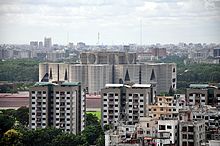
As the capital of the People's Republic of Bangladesh, Dhaka is the home to numerous state and diplomatic institutions. The Bangabhaban is the official residence and workplace of the President of Bangladesh, who is the ceremonial head of state under the constitution. The National Parliament House is located in the modernist capital complex designed by Louis Kahn in Sher-e-Bangla Nagar. The Gonobhaban, the official residence of the Prime Minister, is situated on the north side of Parliament. The Prime Minister's Office is located in Tejgaon. Most ministries of the Government of Bangladesh are housed in the Bangladesh Secretariat.[72] The Supreme Court, the Dhaka High Court and the Foreign Ministry are located in the Ramna area. The Defence Ministry and the Ministry of Planning are located in Sher-e-Bangla Nagar.[72] The Armed Forces Division of the government of Bangladesh and Bangladesh Armed Forces headquarters are located in Dhaka Cantonment.[72] Several important installations of the Bangladesh Army are also situated in Dhaka and Mirpur Cantonments. The Bangladesh Navy's principal administrative and logistics base BNS Haji Mohshin is located in Dhaka.[73] The Bangladesh Air Force maintains the BAF Bangabandhu Air Base and BAF Khademul Bashar Air Base in Dhaka.[74]
Dhaka hosts 54 resident embassies and high commissions and numerous international organizations. Most diplomatic missions are located in Gulshan and Baridhara area of the city. The Agargaon area near Parliament is home to the country offices of the United Nations, the World Bank, the Asian Development Bank and the Islamic Development Bank.
Civic administration
History
Dhaka municipality was founded on 1 August 1864 and upgraded to "Metropolitan" status in 1978. In 1983, the Dhaka City Corporation was created as a self-governing entity to govern Dhaka.[75]
Under a new act in 1993, an election was held in 1994 for the first elected Mayor of Dhaka.[76] The Dhaka City Corporation ran the affairs of the city until November 2011.[77]
Municipal government
In 2011, Dhaka City Corporation was split into two separate corporations – Dhaka North City Corporation and Dhaka South City Corporation for ensuring better civic facilities.[78] These two corporations are headed by two mayors, who are elected by direct vote of the citizen for a 5-year period. The area within city corporations was divided into several wards, which each have an elected commissioner. In total the city has 130 wards and 725 mohallas.
- RAJUK is responsible for coordinating urban development in the Greater Dhaka area.[79]
- DMP is responsible for maintaining law and order within the metro area. It was established in 1976. DMP has 56 police stations as administrative units.[80][81]
Administrative agencies
Unlike other megacities around the world, Dhaka is serviced by over two dozen government organizations under different ministries. Lack of co-ordination among them and centralization of all powers by the Government of Bangladesh, keeps the development and maintenance of the city in a chaotic situation.[82]
| Agency | Service | Parent agency |
|---|---|---|
| Dhaka North City Corporation Dhaka South City Corporation |
Public service | Ministry of Local Government, Rural Development and Co-operatives ∟ Local Government Division |
| Dhaka Metropolitan Police | Law enforcement | Ministry of Home Affairs ∟ Bangladesh Police |
| RAJUK | Urban planning | Ministry of Housing and Public Works |
| Dhaka Electric Supply Company Limited Dhaka Power Distribution Company Limited |
Power distribution | Ministry of Power, Energy and Mineral Resources ∟ Power Division |
| Dhaka WASA | Water supply | Ministry of Local Government, Rural Development and Co-operatives ∟ Local Government Division |
| Dhaka Transport Coordination Authority | Transport | Ministry of Road Transport and Bridges ∟Road Transport and Highways Division |
Economy
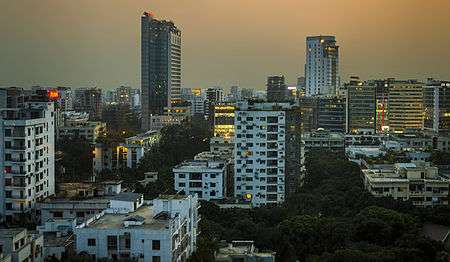
.jpg)
Dhaka is the financial, commercial and the entertainment capital of Bangladesh. It accounts up to 35% of Bangladesh's economy.[17] The Globalization and World Cities Research Network ranks Dhaka as a beta-global city. The city is home to the country's monetary authority, the Bangladesh Bank, and the largest stock market, the Dhaka Stock Exchange. The main commercial areas of the city include Gulshan, Banani, Kawran Bazar, Dhanmondi Motijheel, Mohakhali, and Dilkusha. Tejgaon and Hazaribagh are the major industrial areas.[83] The city has a growing middle class, driving the market for modern consumer and luxury goods.[21][84] Restaurants, shopping malls and luxury hotels continue to serve as vital elements in the city's economy.
The city has historically attracted numerous migrant workers.[85] Hawkers, peddlers, small shops, rickshaw transport, roadside vendors and stalls employ a large segment of the population[85][86] – rickshaw-drivers alone number as many as 400,000.[87] Half the workforce is employed in household and unorganised labour, while about 800,000 work in the textile industry. The unemployment rate in Dhaka was 23% in 2013.[88]
Dhaka has rising congestion and inadequate infrastructure; the national government has recently implemented a policy for rapid urbanization of surrounding areas and beyond by the introduction of a ten-year relief on income tax for new construction of facilities and buildings outside Dhaka.[89]
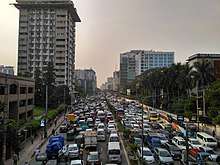
Almost all large local conglomerates have their corporate offices located in Dhaka. Microcredit also began here and the offices of the Nobel Prize-winning Grameen Bank[90] and BRAC (the largest non-governmental development organisation in the world) are based in Dhaka.[91] Urban developments have sparked a widespread construction boom; new high-rise buildings and skyscrapers have changed the city's landscape.[84] Growth has been especially strong in the finance, banking, manufacturing, telecommunications and services sectors, while tourism, hotels and restaurants continue as important elements of the Dhaka economy.[85]
Demographics
The city, in combination with localities forming the wider metropolitan area, is home to over 15 million as of 2013.[92] The population is growing by an estimated 4.2% per year, one of the highest rates amongst Asian cities.[85] The continuing growth reflects ongoing migration from rural areas to the Dhaka urban region, which accounted for 60% of the city's growth in the 1960s and 1970s. More recently, the city's population has also grown with the expansion of city boundaries, a process that added more than a million people to the city in the 1980s.[85] According to the Far Eastern Economic Review, Dhaka will be home to 25 million people by the end of 2025.[93]
The literacy rate in Dhaka is also increasing quickly. It was estimated at 69.2% in 2001. The literacy rate had gone up to 74.6% by 2011[94] which is significantly higher than the national average of 72%.[95]
The city population is composed of people from virtually every region of Bangladesh. The long-standing inhabitants of the old city are known as Dhakaite and have a distinctive dialect and culture. Dhaka is also home to a large number of Bihari refugees, who are descendants of migrant Muslims from eastern India during 1947 and settled down in East Pakistan. The correct population of Biharis living in the city is ambiguous, but it is estimated that there are at least 300,000 Urdu-speakers in all of Bangladesh, mostly residing in old Dhaka and in refugee camps in Dhaka, although official figures estimates only 40,000.[96][97][98] Between 15,000 and 20,000 of the Rohingya, Santal, Khasi, Garo, Chakma and Mandi tribal peoples reside in the city.[99]
Most residents of Dhaka speak Bengali, the national language. Many distinctive Bengali dialects and regional languages such as Dhakaiya Kutti, Chittagonian and Sylheti are also spoken by segments of the population. English is spoken by a large segment of the population, especially for business purposes. Urdu, including Dhakaiya Urdu, is spoken by members of several non-Bengali communities, including the Biharis.[100]
Islam is the dominant religion of the city, with 94% of the population being Muslim, and a majority belonging to the Sunni sect. There is also a small Shia sect, and an Ahmadiya community. Hinduism is the second-largest religion and comprises 5% of the population. Smaller segments practice Christianity and Buddhism.[101]
| Year | Pop. | ±% |
|---|---|---|
| 1950 | 335,760 | — |
| 1960 | 507,921 | +51.3% |
| 1970 | 1,373,718 | +170.5% |
| 1980 | 3,265,663 | +137.7% |
| 1990 | 6,620,697 | +102.7% |
| 2000 | 10,284,947 | +55.3% |
| 2010 | 14,730,537 | +43.2% |
| 2020 | 21,005,860 | +42.6% |
| for Dhaka Agglomeration:[102] | ||
Culture
Arts and festivals
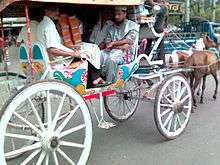
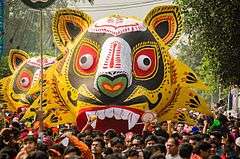
As the most populous city of Bangladesh, Dhaka has a vibrant cultural life. Annual celebrations for Independence Day (26 March), Language Martyrs' Day (21 February) and Victory Day (16 December) are prominently celebrated across the city. Dhaka's people congregate at the Shaheed Minar and the Jatiyo Smriti Soudho to remember the national heroes of the liberation war. These occasions are observed with public ceremonies and rallies in public grounds. Many schools and colleges organise fairs, festivals and concerts in which citizens from all levels of society participate.[103] Pohela Baishakh, the Bengali New Year, falls annually on 14 April and is popularly celebrated across the city.[103] Large crowds of people gather on the streets of Shahbag, Ramna Park and the campus of the University of Dhaka for celebrations. Pahela Falgun (Bengali: পহেলা ফাল্গুন), the first day of spring of the Bengali month Falgun, in the Bengali calendar, is also celebrated in the city in a festive manner.[104] This day is marked with colourful celebration and traditionally, women wear yellow saris to celebrate this day. This celebration is also known as Basanta Utsab (Bengali: বসন্ত উৎসব; Spring Festival). Nabanna is a harvest celebration, usually celebrated with food and dance and music on the 1st day of the month of Agrahayan of the Bengali year. Birthdays of Rabindranath Tagore and Kazi Nazrul Islam are observed respectively as Rabindra Jayanti and Nazrul Jayanti. The Ekushey Book Fair, which is arranged each year by Bangla Academy, takes place for the whole month of February. This event is dedicated to the martyrs who died on 21 February 1952 in a demonstration calling for the establishment of Bengali as one of the state languages of former East Pakistan. Shakrain Festival (Bengali: সাকরাইন) is an annual celebration observed with the flying of kites.[105] It is usually observed in the old part of the city at the end of Poush, the ninth month of the Bengali calendar (14 or 15 January in the Gregorian calendar).
Islamic festivals of Eid ul-Fitr, Eid ul-Adha, Eid-E-Miladunnabi and Muharram; Hindu festival of Durga Puja; Buddhist festival of Buddha Purnima; and Christian festival of Christmas witness widespread celebrations across the city.
The most popular dressing style for women are sarees or salwar kameez, while men usually prefer western clothing to the traditional lungi with Panjabi. The Jamdani saree of Dhaka is part of its cultural heritage, and originates from the Mughal era. Jamdani sarees are 100% hand woven and a single saree may take as long as three months to complete.[106]
Despite the growing popularity of music groups and rock bands, traditional folk music remains widely popular.[107] The works of the national poet Kazi Nazrul Islam and national anthem writer Rabindranath Tagore have a widespread following across Dhaka.[108] The Baily Road area is known as Natak Para (Theatre Neighbourhood) which is the center of Dhaka's thriving theatre movement.[109]
For much of recent history, Dhaka was characterized by roadside markets and small shops that sold a wide variety of goods.[110] Recent years have seen the widespread construction of shopping malls.[111] Two of the largest shopping malls in Dhaka and perhaps in the Indian subcontinent are Jamuna Future Park and Bashundhara City shopping mall.
Cuisines

The Old Dhaka area has its own unique food tradition, known as Dhakaite (ঢাকাইয়া) food. Old Dhaka is famous for its Morog (Chicken) Pulao, which is different from traditional biryani by its use of both turmeric and malai or cream of milk together.[112]
Dhakai Bakarkhani is the traditional food or snack of the people of old Dhaka. It is famous for its quality and taste and it was highly praised by the royal court of the Mughal Empire in Delhi.[113] Along with Bangladeshi cuisine and South Asian variants, a large variety of Western and Chinese cuisine is served at numerous restaurants and eateries.[84]
Architecture
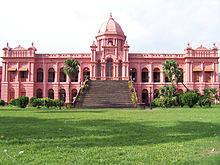
Dhaka is home to over 2000 buildings built between the 16th and 19th centuries, which form an integral part of Dhaka's cultural heritage. Examples include Binat Bibi Mosque, Lalbagh Fort, Ahsan Manzil, Tara Mosque, Chawk Mosque, Hussaini Dalan, Armenian Church, Curzon Hall, Dhaka Gate, Dhanmondi Shahi Eidgah, Rose Garden Palace, Choto Katra, Bara Katra, Dhakeshwari Temple, Swami Bagh Temple, Ramna Kali Mandir, Holy Rosary Church, and Pogose School. There are still many colonial buildings in the Dhaka Sadarghat, Armanitola, and Farashganj areas of Old Dhaka. Binat Bibi Mosque was built in 1454 in the Narinda area of Dhaka during the reign of the Sultan of Bengal, Nasiruddin Mahmud Shah (r. 1435 – 1459),[114] and is the oldest brick structure that still exists in the city.[115] Important landmark buildings constructed during British rule include the Old High Court Building, Bangabhaban, Curzon Hall and Mitford Hospital.
Architect Louis I Kahn's acclaimed modernist National Capital Complex, based on the geography and heritage of Bengal, was inaugurated in Dhaka in 1982 as one of the largest legislative complexes in the world, comprising 200 acres (800,000 m22.[116] Designed by American architect Robert Boughey, Kamalapur railway station is another architectural marvel, which was constructed in the early 1960s and started operation from 1969. Independence Monument (Bengali: স্বাধীনতা স্তম্ভ) is a new landmark, which was built to commemorate the historical events that took place in the Suhrawardy Udyan during the Liberation War of Bangladesh.
Media
.jpg)
Dhaka is also the press, media and entertainment center of Bangladesh. Bangladesh Betar is the state-run primary provider of radio services, and broadcasts a variety of programming in Bengali and English. Radio transmission started in Dhaka on 16 December 1939. In recent years many private radio networks, especially FM radio services, have been established in the city such as Radio Foorti FM 88.0, Radio Aamar FM 88.4, ABC Radio FM 89.2, Radio Today FM 89.6, DhakaFM 90.4, Peoples Radio 91.6 FM, Radio Bhumi FM 92.8, and City FM 96.0.
Bangladesh Television is the state-run broadcasting network that provides a wide variety of programmes in Bengali and English. It started broadcasting on 25 December 1964. It also operates a sister channel BTV World since 2004. Sangsad Bangladesh is another government-owned TV channel that broadcasts parliamentary activity of Bangladesh since 25 January 2011. Cable and satellite networks such as ATN Bangla, ATN News, Banglavision, Channel i, Channel 9, Ekushey Television, Gaan Bangla, Gazi Television, Independent TV, NTV, RTV and Somoy TV are amongst the most popular channels.
The main offices of most publishing houses in Bangladesh are based in Dhaka. Dhaka is home to the largest Bangladeshi newspapers, including the leading Bengali dailies Prothom Alo, Ittefaq, Inqilab, Janakantha, Amar Desh and Jugantor. The leading English-language newspapers include The Daily Star, Dhaka Tribune, The Financial Express, The Independent and New Age.[117]
Education
Dhaka has the largest number of schools, colleges and universities of any Bangladeshi city. The education system is divided into five levels: Primary (from grades 1 to 6), Junior (from grades 6 to 8), Secondary (from grades 9 to 10), Higher Secondary (from grades 11 to 12) and tertiary.[118] The five years of Primary education concludes with a Primary School Completion (PSC) Examination, the three years of Junior education concludes with Junior School Certificate (JSC) Examination, and next two years of Secondary education concludes with a Secondary School Certificate (SSC) Examination. Students who pass this examination proceed to two years of Higher Secondary or intermediate training, which culminate in a Higher Secondary School Certificate (HSC) Examination.[118] Education is mainly offered in Bengali, but English is also widely taught and used. Many Muslim families send their children to attend part-time courses or even to pursue full-time religious education alongside other subjects, which is imparted in Bengali and Arabic in schools, colleges and madrasas.[118]
There are 52 universities in Dhaka. Dhaka College is the oldest institution for higher education in the city and among the earliest established in British India, founded in 1841. Since independence, Dhaka has seen the establishment of numerous public and private colleges and universities that offer undergraduate and graduate degrees as well as a variety of doctoral programmes.[119] University of Dhaka is the oldest public university[120] in the country which has more than 30,000 students and 1,800 faculty staff. It was established in 1921 being the first university in the region. The university has 23 research centers and 70 departments, faculties and institutes.[121] Eminent seats of higher education include Bangladesh University of Engineering and Technology (BUET), Bangabandhu Sheikh Mujib Medical University (BSMMU), Jagannath University and Sher-e-Bangla Agricultural University. Dhaka Medical College and Sir Salimullah Medical College are two of the best medical colleges in the nation.[122] Founded in 1875, the Dhaka Medical School was the first medical school in Bangladesh (then British East Bengal), which became Sir Salimullah Medical College in 1962.[123] Other government medical colleges are Shaheed Suhrawardy Medical College and Armed Forces Medical College, Dhaka.
Alongside public institutes of higher education there are some 45 private universities in Dhaka, most of which are located in the Mohakhali, Gulshan, Banani, Baridhara, Bashundhara, Uttara and Dhanmondi areas of the city. Notre Dame College, Dhaka is also well known for their good result in HSC.
The British Council plays an important role helping students to achieve GCSE and A Level qualifications from examination boards in the United Kingdom. This is in addition to holding several examinations for professional bodies in the United Kingdom, including the UK medical Royal Colleges and Accountancy.
Sports
Cricket and football are the two most popular sports in Dhaka and across the nation.[124] Teams are fielded in intra-city and national competitions by many schools, colleges and private entities. The Mohammedan Sporting Club and Abahani are two of the most famous football and cricket teams, maintaining a fierce rivalry, especially in the Bangladesh Football Premier League.[125] The Dhaka Metropolis cricket team represents Dhaka city in the National Cricket League, a region-based domestic first-class cricket competition in Bangladesh. The Dhaka Premier League is the only domestic List A cricket tournament now in Bangladesh. It gained List A status in 2013–14 season.[126] In domestic Twenty20 cricket, Dhaka has a BPL franchise known as Dhaka Dynamites.
Dhaka has the distinction of having hosted the first official Test cricket match of the Pakistan cricket team in 1954 against India.[127] The Bangabandhu National Stadium was formerly the main venue for domestic and international cricket matches, but now exclusively hosts football matches.[127] It was used during the Pakistani colonial era for Test matches when no Bengalis were selected to the team and a matting pitch was used. It hosted the opening ceremony[128] of the 2011 Cricket World Cup while the Sher-e-Bangla National Cricket Stadium, exclusively used for cricket, hosted 6 matches of the tournament including two quarter-final matches.[129] Dhaka has also hosted the South Asian Games three times, in 1985, 1993 and 2010. Dhaka is the first city to host the games three times. The Bangabandhu National Stadium was the main venue for all three editions.[130] Dhaka also hosted the ICC World Twenty20, along with Chittagong and Sylhet, in 2014.
The National Sports Council, responsible for promoting sports activities across the nation, is based in Dhaka. Dhaka also has stadiums largely used for domestic events such as the Bangladesh Army Stadium, the Bir Sherestha Shaheed Shipahi Mostafa Kamal Stadium, the Dhanmondi Cricket Stadium, the Maulana Bhasani Hockey Stadium and the Outer Stadium Ground.[131] The Dhaka University Ground and the BUET Sports Ground host many intercollegiate tournaments.[132] They are also used as practice grounds by different football clubs and visiting foreign national football teams.
There are two golf courses in Dhaka, Army Golf Club and Kurmitola Golf Club.[133]
Transport
Road
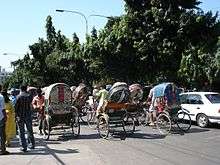
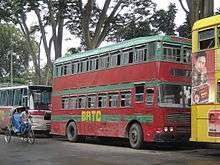
Dhaka is connected to the other parts of the country through highway and railway links. Five of the eight major national highways of Bangladesh start from the city: N1, N2, N3, N5 and N8. Dhaka is also directly connected to the two longest routes of the Asian Highway Network: AH1 and AH2, as well as to the AH41 route. Highway links to the Indian cities of Kolkata, Agartala, Guwahati and Shillong have been established by the Bangladesh Road Transport Corporation (BRTC) and private bus companies which also run regular international bus services to those cities from Dhaka.[134][135] An elevated expressway system is under construction.[136] The Dhaka Elevated Expressway would run from Shahjalal International Airport-Kuril-Banani-Mohakhali-Tejgaon-Saatrasta-Moghbazar Rail Crossing-Khilgaon-Kamalapur-Golapbagh to Dhaka-Chittagong Highway at Kutubkhali Point. A longer second elevated expressway from Airport-Ashulia is undergoing feasibility studies.[137] There are three inter-district bus terminals in Dhaka, which are located at the Mohakhali, Saidabad and Gabtoli areas of the city.
Dhaka suffers some of the worst traffic congestion in the world. The city lacks an organized public transport system. Construction of MRT and a BRT may solve the problem. Cycle rickshaws and auto rickshaws are the main mode of transport within the metro area, with close to 400,000 rickshaws running each day: the highest number in any city in the world.[138][139][140][141][142][84][86] However, only about 85,000 rickshaws are licensed by the city government.[85][143] Relatively low-cost and non-polluting cycle rickshaws, nevertheless, cause traffic congestion and have been banned from many parts of the city. The government has overseen the replacement of two-stroke engine auto rickshaws with "green auto-rickshaws" locally called CNG auto-rickshaw or Baby-taxi, which run on compressed natural gas.[144]
Public buses are operated by the state-run Bangladesh Road Transport Corporation (BRTC) and by numerous private companies and operators. Ride-sharing services like Uber and Pathao as well as scooters and privately owned cars are popular modes of transportation. Limited numbers of taxis are available. It is planned to raise the total number of taxis to 18,000 gradually.[145][146][147]
Air
Shahjalal International Airport (IATA: DAC, ICAO: VGHS), located 15 kilometres (9.3 mi) north of Dhaka city centre is the largest and busiest international airport in the country.[148] The airport has an area of 1,981 acres (802 ha). The airport has a capacity of handling 15 million passengers annually,[149] and is predicted by the Civil Aviation Authority, Bangladesh to be sufficient to meet demand until 2026.[150] In 2014, it handled 6.1 million passengers, and 248,000 tonnes of cargo.[151] Average aircraft movement per day is around 190 flights.[152] It is the hub of all Bangladeshi airlines. Domestic service flies to Chittagong, Sylhet, Rajshahi, Cox's Bazar, Jessore, Barisal, Saidpur and international services fly to major cities in Asia, Europe and the Middle East.[153][154]
Rail
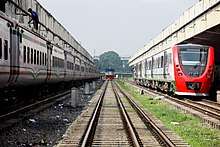
Kamalapur railway station is the largest and busiest among the railway stations in the city. Designed by American architect Robert Boughey, the railway station situated in the north-east side of Motijheel was established in the early 1960s and started operation from 1969.[155] The station is the largest in the country and also one of the most modern and striking buildings in Dhaka. The state-owned Bangladesh Railway provides suburban and national services with regular express train services connecting Dhaka with major cities of Chittagong, Rajshahi, Khulna, Sylhet and Rangpur.[156] The Maitree Express provides international service to Kolkata. .
In 2013, suburban services to Narayanganj and Gazipur cities were upgraded using diesel electric multiple unit trains.[157][158]
The Dhaka Metro Rail feasibility study has been completed. A 20.1-kilometre (12.5 mi), $1.7-billion Phase 1 metro route is being negotiated by the Government with Japan International Cooperation Agency. The first route will start from Uttara, a northern suburb of Dhaka, and extend to Sayedabad, in the southern section of Dhaka.[159] The route consists of 16 elevated stations each 180 metres (590 ft) long. Construction began on 26 June 2016.[160]
Waterways
The Sadarghat River Port on the banks of the Buriganga River serves for the transport of goods and passengers upriver and to other ports in Bangladesh.[161] Inter-city and inter-district motor vessels and passenger-ferry services are used by many people to travel riverine regions of the country from the city. Water bus services are available on Buriganga River and Hatirjheel and Gulshan lakes. Water buses of the Buriganga River ferry passengers on Sadarghat to Gabtali route.[162] Water taxis in Hatirjheel and Gulshan lakes provide connectivity via two routes, one route between Tejgaon and Gulshan and the other route between the Tejgaon and Rampura areas.[163]
Twin towns and sister cities
Dhaka is twinned with:
See also
- List of cities proper by population
- List of metropolitan areas in Asia
- List of most expensive cities for expatriate employees
- List of urban agglomerations in Asia
- List of urban areas by population
References
- "Hasan Mahmud states 3 reasons behind low voter turnout". The Daily Star. UNB. 2 February 2020.
- Partha Pratim Bhattacharjee; Mahbubur Rahman Khan (7 May 2016). "Govt to double size of Dhaka city area". The Daily Star.
- "Dhaka City expands by more than double after inclusion of 16 union councils". bdnews24.com. 9 May 2016.
- http://wikimapia.org/26768999/Dhaka-Metropolitan-City-Area
- "Dhaka, Bangladesh Map". National Geographic. Retrieved 6 September 2009.
- sum for 41 thanas of Dhaka city, not including 5 upazilas of Dhaka district
- "Population & Housing Census-2011" (PDF). Bangladesh Bureau of Statistics. p. 41. Archived from the original (PDF) on 8 December 2015. Retrieved 15 December 2015.
- Choguill, C.L. (2012). New Communities for Urban Squatters: Lessons from the Plan That Failed in Dhaka, Bangladesh. Springer Science & Business Media. p. viii. ISBN 978-1-4613-1863-7.
- "The 10 Largest Cities In The World". World Atlas. 20 December 2019. Retrieved 27 March 2020.
- "Sector Assessment (Summary): Urban Transport" (PDF). Asian Development Bank.
- Population and Housing Census 2011 - Volume 3: Urban Area Report (PDF), Bangladesh Bureau of Statistics, retrieved 8 July 2020
- "Dhaka Population". World Population Review. 26 October 2018. Retrieved 18 March 2019.
- "Dhaka, Bangladesh Population 1950-2020". Macrotrends. Retrieved 27 March 2020.
- Hough, Michael (1 January 2004). "Cities and Natural Process: A Basis for Sustainability". Psychology Press.
- Dani, Ahmad (1962), Dacca – A record of its changing fortunes, Mrs. Safiya S Dani, p. 119
- http://bdlaws.minlaw.gov.bd/print_sections_all.php?id=367
- Rezaul Karim (24 February 2017). "Dhaka's economic activities unplanned: analysts". The Daily Star.
- "Dhaka". Britannica. Retrieved 22 February 2019.
- "Dhaka". Encyclopædia Britannica. Retrieved 4 February 2013.
- "Islam Khan Chisti". Banglapedia. Retrieved 4 February 2013.
- Chowdhury, A.M. (23 April 2007). "Dhaka". Banglapedia. Retrieved 23 April 2007.
- Mamoon, Muntassir (2010) [First published 1993]. Dhaka: Smiriti Bismiritir Nogori. Anannya. p. 94.
- Dhaka City Corporation (5 September 2006). "Pre-Mughal Dhaka (before 1608)". Archived from the original on 10 April 2008. Retrieved 1 December 2015.
- "From Jahangirnagar to Dhaka". Forum. The Daily Star. Archived from the original on 8 February 2015. Retrieved 18 February 2015.
- Kraas, Frauke; Aggarwal, Surinder; Coy, Martin; Mertins, Günter, eds. (2013). Megacities: Our Global Urban Future. Springer. p. 60. ISBN 978-90-481-3417-5.
- "State of Cities: Urban Governance in Dhaka" (PDF). BRAC University. May 2012.
- Shay, Christopher. "Travel – Saving Dhaka's heritage". BBC. Retrieved 18 February 2015.
- Colley, Linda (2009). The Ordeal of Elizabeth Marsh: A Woman in World History. Knopf Doubleday Publishing Group. pp. 262–. ISBN 978-0-307-53944-1.
- Muntassir Mamoon, Ḍhākā Nagara Jādughara. Ḍhākā granthamālā Vol. 11 Ḍhākā Nagara Jādughara, 1991 (original from the University of California, digitalized 2008). pp 18–20
- "Which India is claiming to have been colonizsed?". The Daily Star (Op-ed). 31 July 2015.
- Indrajit Ray (2011). Bengal Industries and the British Industrial Revolution (1757-1857). Routledge. pp. 57, 90, 174. ISBN 978-1-136-82552-1.
- Srangio, Sebastian (1 October 2010). "Dhaka: Saving Old Dhaka's Landmarks". The Caravan. Archived from the original on 9 September 2015.
- "WORLDVIEW".
- Lalbagh Kella (Lalbagh Fort) Dhaka Bangladesh 2011 54.JPG
- "Rare 1857 reports on Bengal uprisings – The Times of India". The Times of India.
- "Dhaka WASA". Dwasa.org.bd. Retrieved 18 February 2015.
- http://en.banglapedia.org/index.php?title=Railway
- http://en.banglapedia.org/index.php?title=Film,_Feature
- "History of Electricity in Bangladesh | Thcapriciousboy". Tusher.kobiraj.com. 18 July 2013. Archived from the original on 16 February 2015. Retrieved 18 February 2015.
- http://www.cdrb.org/journal/2003/3/3.pdf
- http://open_jicareport.jica.go.jp/pdf/11996774_06.pdf
- Pakistan Affairs. Information Division, Embassy of Pakistan. 1968. p. 19.
- Richards, John. "Calcutta and Dhaka: A tale of two cities" (PDF). Inroads. Retrieved 29 June 2015.
- "Sheikh Mujibur Rahman". Virtual Bangladesh. Retrieved 18 February 2015.
- Richards, John. "Calcutta and Dhaka: A tale of two cities" (PDF). Inroads. Retrieved 29 June 2015.
- "The Pearson General Knowledge Manual 2012 – Edgar Thorpe". 23 March 1971. Retrieved 18 February 2015.
- "Centuries of Genocide: Essays and Eyewitness Accounts". Retrieved 18 February 2015.
- "Science, Technology, Imperialism, and War". Retrieved 18 February 2015.
- "Fall of Dhaka: Memories of a bloody December – Pakistan". Dawn. Pakistan. Retrieved 18 February 2015.
- Salik, Siddiq (1997). Witness to Surrender. ISBN 984-05-1374-5.
- Jacob, Lt. Gen. JFR, Surrender at Dacca:Birth of a Nation
- http://worldpopulationreview.com/world-cities/dhaka-population/
- http://www.saarc-sec.org/userfiles/01-Dhaka-1stSummit1985.pdf
- Habib, Haroon (24 January 1998). "An economic initiative". Frontline.
- Hossain, Shahadat (January 2008). "Rapid Urban Growth and Poverty in Dhaka City" (PDF). Bangladesh e-Journal of Sociology. 5 (1).
- https://www.pri.org/stories/2010-09-08/dhaka-fastest-growing-megacity-world
- Beyond Hartals: Towards Democratic Dialogue in Bangladesh (PDF). United Nations Development Programme (UNDP) Bangladesh. March 2005. ISBN 984-32-1424-2. Archived from the original (PDF) on 5 March 2018. Retrieved 4 March 2018.
- http://content.time.com/time/specials/packages/article/0,28804,2097720_2097718_2097713,00.html
- "Dhaka, Bangladesh: Fastest Growing City in the World". CBS News. Retrieved 22 February 2019.
- http://resilient-cities.iclei.org/fileadmin/sites/resilient-cities/files/docs/B4-Bonn2010-Hamidul.pdf
- "Welcome to the Traffic Capital of the World". The New Republic. Retrieved 22 February 2019.
- Hough, Michael (2004). Cities and natural process. Routledge. pp. 64–65. ISBN 0-415-29855-5.
- "Weatherbase: Historical Weather for Dhaka, Bangladesh". weatherbase.com. Retrieved 15 December 2008.
- Mondal, M. Abdul Latif (27 September 2006). "Our Cities: 15th Anniversary Special". The Daily Star. Archived from the original on 2 March 2007. Retrieved 27 September 2006.
- Sohara Mehroze Shachi (5 September 2018). "Bangladesh's Air Pollution Problem Grows, Brick by Brick". Undark. Retrieved 7 September 2018.
The kiln operations alone – while representing just 1 percent of the country's GDP – generate nearly 60 percent of the particulate pollution in Dhaka, according to Bangladesh’s Department of Environment (DOE).
- "Climate of Bangladesh" (PDF). Bangladesh Meteorological Department. pp. 19–23. Archived from the original (PDF) on 24 December 2018. Retrieved 24 December 2018.
- "Normal Monthly Rainy Day" (PDF). Bangladesh Meteorological Department. Archived from the original on 9 July 2017. Retrieved 26 April 2018.
- "Normal Monthly Humidity" (PDF). Bangladesh Meteorological Department. Archived from the original on 24 December 2018. Retrieved 26 April 2018.
- "Bangladesh – Dacca" (PDF) (in Spanish). Centro de Investigaciones Fitosociológicas. Retrieved 23 February 2013.
- "Station 41923 Dhaka". Global station data 1961–1990—Sunshine Duration. Deutscher Wetterdienst. Archived from the original on 17 October 2017. Retrieved 26 April 2018.
- "Station ID for Dhaka is 41923". Archived from the original on 17 October 2017. Retrieved 26 April 2018.
- "List of Ministries and Divisions". cabinet.gov.bd. 20 November 2016. Retrieved 27 November 2016.
- "Navy Bases". Bangladesh Navy. Archived from the original on 27 May 2019. Retrieved 30 January 2017.
- joinbangladeshairforce.mil.bd. "Locations of Bangladesh Air Force Bases". joinbangladeshairforce.mil.bd. Archived from the original on 19 January 2017. Retrieved 30 January 2017.
- Md Shahnawaz Khan Chandan (8 May 2015). "Reminiscing Dhaka's Legacy". Star Weekend Magazine. The Daily Star.
- "Mayor Hanif's death anniversary today". The Daily Star. 28 November 2010. Retrieved 12 February 2015.
- "Don't split Dhaka, Khoka urges govt". UNBConnect. 12 November 2011. Archived from the original on 5 April 2012. Retrieved 12 September 2012.
- Hasan Jahid Tusher (18 October 2011). "Dhaka set to split into two". The Daily Star. Retrieved 12 February 2015.
- Islam, Md Asraful. "Rajdhani Unnayan Kartripakkha". Banglapedia. Retrieved 26 July 2015.
- "History of the DMP". Dhaka Metropolitan Police. Archived from the original on 19 October 2013. Retrieved 18 October 2013.
- "DMP – New Initiatives". Dhaka Metropolitan Police. Archived from the original on 16 September 2010. Retrieved 30 September 2008.
- "What should we do for better civic services". The Daily Star. 23 January 2016. Retrieved 18 June 2016.
- "Dhaka City State of Environment" (PDF). Regional Resource Center for Asia and the Pacific, United Nations Environment Programme. 2005. Archived from the original (pdf) on 7 February 2009. Retrieved 24 January 2009.
- Lawson, Alistair (1 June 2002). "Good times for bourgeois Bangladeshis". BBC News. Retrieved 2 October 2006.
- McGee, Terry (27 September 2006). "Urbanization Takes on New Dimensions in Asia's Population Giants". Population Reference Bureau. Archived from the original on 14 February 2008. Retrieved 27 September 2006.
- "Does Dhaka need rickshaws?". BBC News. 20 July 1998. Retrieved 27 September 2006.
- Robert Cervero (2000). Informal Transport in the Developing World. UN-HABITAT. p. 39. ISBN 92-1-131453-4.
- Dhaka City Corporation. "Dhaka City at a Glance". Archived from the original on 15 January 2013. Retrieved 1 December 2015.
- "Town planning for Bangladesh: Vision 2020". The Daily Star. 8 November 2008. Retrieved 15 December 2008.
- "Poverty Alleviation: Yunus calls for major reforms in World Bank". The Daily Star. 5 November 2007.
- "Blind eye to urban poor to spell social disaster:Conference on the poor told". The Daily Star. 5 December 2007.
- "Evolving Urban Form: Dhaka". Newgeography.com. Retrieved 26 June 2013.
- "Planet of Slums by Mike Davis". Asia Times. 20 May 2006. Retrieved 8 May 2010.
- "Statistical Yearbook of Bangladesh 2012, Page 35" (PDF). Bangladesh Bureau of Statistics. Archived from the original (PDF) on 7 August 2015. Retrieved 14 May 2015.
- "Govt ready to offer nationality to Urdu-speaking people: Moni". The Financial Express. Dhaka. Archived from the original on 4 November 2011. Retrieved 12 April 2011.
- "Socio-economic Problems of the Urdu Speaking Residents at Mohammadpur" (PDF). Democracy Watch. Retrieved 12 April 2011.
- Persoob, Tasmia. "The Forgotten Community: Camp Based Urdu Speaking People in Bangladesh" (PDF). Jahangirnagar University. Archived from the original (PDF) on 22 March 2012. Retrieved 12 April 2011.
- "::Our Cities::15th Anniversary Special". The Daily Star. Archived from the original on 2 March 2007. Retrieved 8 May 2010.
- Sanghamitra Saha (2001). A Linguist Visits Bangladesh: A Travelogue. International School of Dravidian Linguistics. p. 8. ISBN 8185692300.
- "Population Census 2011: Dhaka Table C-13" (PDF). Bangladesh Bureau of Statistics. Archived from the original (PDF) on 13 November 2014. Retrieved 11 July 2014.
- Dhaka population
- Ahmed, Dr. Nizamuddin (27 September 2006). "Happy 400th anniversary, Dhaka!". The Daily Star. Archived from the original on 2 March 2007. Retrieved 27 September 2006.
- "Pohela Falgun celebrated". The Daily Star. 14 February 2011.
- "Shakrain festival". The Daily Star. 19 January 2011. Retrieved 14 January 2019.
- Roy, Tirthankar (2007). "Out of Tradition: Master Artisans and Economic Change in Colonial India". The Journal of Asian Studies. Cambridge University Press. 66: 963–991. doi:10.1017/s002191180700126x.
- Thomas Angotti & Lothar Beckel (2001). Mega Cities. GEOSPACE Beckel Satellitenb. p. 730. ISBN 3-85313-051-8.
- Alison Arnold (1999). The Garland Encyclopedia of World Music: The Indian Subcontinent. Routledge. pp. 858–859. ISBN 0-8240-4946-2.
- Ian Herbert & Nicole Leclercq (2000). The World of Theatre. Taylor & Francis. p. 12. ISBN 0-415-23866-8.
- Jeremy Seabrook (1996). In the Cities of the South: Scenes from a Developing World. Verso Books. p. 221. ISBN 1-85984-081-7.
- World and Its Peoples. Marshall Cavendish Corporation. 2008. p. 489. ISBN 0-7614-7631-8.
- "Treasures of Bangladeshi cuisine". The Daily Star. 24 February 2017. Retrieved 1 March 2017.
- Melvin Ember, Carol R. Ember (2002). Encyclopedia of Urban Cultures : Cayenne-Kyoto: Cities and Cultures Around the World. Grolier. p. 147. ISBN 0-7172-5698-7.
- "Binat Bibi Mosque". ArchNet Digital Library. Archived from the original on 1 March 2006. Retrieved 18 September 2012.
- From Jahangirnagar to Dhaka by Faruque Hasan in The Daily Star
- Ali, Meer Mobashsher; Rouf, Md Abdur (2012). "Jatiya Sangsad Bhaban". In Islam, Sirajul; Jamal, Ahmed A. (eds.). Banglapedia: National Encyclopedia of Bangladesh (Second ed.). Asiatic Society of Bangladesh.
- John Simpson (2006). The Traveler's Handbook. Globe Pequot. p. 195. ISBN 0-7627-4090-6.
- T. Neville Postlethwaite (1988). The Encyclopedia of Comparative Education and National Systems of Education. Pergamon Press. p. 130. ISBN 0-08-030853-8.
- Kamal Siddiqui (1990). "Growth of academic institutions". Social Formation in Dhaka City: A Study in Third World Urban Sociology. Dhaka: University Press Limited. p. 42.
- "Dhaka teachers on violence charge". BBC News. 11 December 2007. Retrieved 15 May 2008.
- University of Dhaka.03710. (10 September 2006). "Univ. Facts". Archived from the original (PHP) on 4 September 2006. Retrieved 10 September 2006.
- Muhammad Shamsul Huq (1983). Higher Education and Employment in Bangladesh. UNESCO. p. 181.
- Shahida Alam (2012), "Mitford Hospital", in Sirajul Islam and Ahmed A. Jamal (ed.), Banglapedia: National Encyclopedia of Bangladesh (Second ed.), Asiatic Society of Bangladesh
- Robert MacHenry, ed. (1993). "Bangladesh". The New Encyclopædia Britannica. Encyclopædia Britannica. p. 717. ISBN 0-85229-571-5.
- Al Musabbir Sadi (17 June 2007). "Tasty derby drawn". The Daily Star.
- "Revamped Dhaka League ready for kick-off". ESPNcricinfo. Retrieved 30 January 2017.
- "Stadium". ESPNcricinfo. 7 September 2006. Retrieved 26 May 2006.
- "Cricket World Cup: Grand ceremony launches tournament". BBC Sport. 17 February 2011.
- "ICC Cricket World Cup 2010/11 / Results". ESPNcricinfo. Retrieved 20 June 2011.
- "11th South Asian Games to start in January 2010". Retrieved 21 March 2009.
- "Grounds – Bangladesh: Dhaka". ESPNcricinfo. Retrieved 13 March 2008.
- Muhammad Abdur Rahim (1981). The History of the University of Dacca. University of Dacca. p. 161.
- "Bangladesh Golf Federation Member list". Bangladesh Golf Federation. Retrieved 30 January 2017.
- Lawson, Alastair (13 October 2003). "Passengers shun Dhaka-India bus". BBC News. Retrieved 7 September 2006.
- "Details of Bus Services". hcidhaka.gov.in. Archived from the original on 2 February 2017.
- "No more push for PPP initiative". The Daily Star. 10 June 2011.
- "Govt plans to build 2nd expressway". daily-sun. 22 June 2011.
- Lawson, Alastair (10 May 2002). "Dhaka's beleaguered rickshaw wallahs". BBC News. Retrieved 17 December 2008.
- "rickshaw: Dhaka". Encyclopædia Britannica. Archived from the original on 16 January 2009. Retrieved 17 December 2008.
- Cervero, Robert. Informal Transport in the Developing World. Nairobi: UN Habitat. ISBN 9211314534.
- Menchetti, Peter (24 March 2005). "Cycle Rickshaws in Dhaka, Bangladesh" (PDF). Thesis for Amsterdam University. Retrieved 15 April 2008.
- Lawson, Alastair (5 October 2002). "Dhaka". BBC News. Retrieved 24 February 2009.
- Rizanuzzaman Laskar (4 March 2007). "Rickshaw pullers get licences". The Daily Star.
- Rahman, Mushfiqur (2003). "Compressed Natural Gas". In Islam, Sirajul (ed.). Banglapedia: National encyclopedia of Bangladesh. Dhaka: Asiatic Society of Bangladesh. ISBN 984-32-0576-6. OCLC 52727562. Retrieved 17 January 2008.
- "Govt to import 5,000 taxis". The Daily Star. 10 May 2013. Retrieved 15 May 2013.
- "Uber taxis in Dhaka". The Daily Star (Editorial). 10 May 2013. Retrieved 27 November 2016.
- "Cabinet nods guideline draft legalizing Uber, Pathao". Dhaka Tribune. 15 January 2018. Retrieved 11 September 2018.
- Alam, Jobair Bin (2003). "Air Transport". In Islam, Sirajul (ed.). Banglapedia: National encyclopedia of Bangladesh. Dhaka: Asiatic Society of Bangladesh. ISBN 984-32-0576-6. OCLC 52727562. Retrieved 17 January 2008.
- Byron, Rejaul Karim (28 August 2010). "New int'l airport to cost Tk 50,000cr". The Daily Star. Retrieved 16 November 2011.
- "AIRPORT DEVELOPMENT HISTORY". Civil Aviation Authority, Bangladesh. Retrieved 16 November 2011.
- "CAAB initiates efforts to expand and upgrade HSIA To build a new airport for Dhaka". The Bangladesh Monitor. 1 April 2015. Archived from the original on 5 April 2015. Retrieved 21 July 2013.
- "Shahjalal airport set for upgrade in two months". Retrieved 4 June 2015.
- "Biman's Destination: International Destinations". Biman Bangladesh Airlines. Archived from the original on 1 July 2013.
- "Dhaka – Zia International Airport (DAC)". World Executive. OE Interactive.
- Ershad Ahmed. "Dhaka". blogspot.com. Retrieved 18 February 2014.
- Marika McAdam (2004). Bangladesh. Lonely Planet. p. 66. ISBN 1-74059-280-8.
- "PM inaugurates Dhaka-Narayanganj DEMU train". Bdnews24.com. 24 April 2013. Retrieved 1 May 2013.
- "Demu train service introduced on Dhaka-Joydebpur". Dhaka Tribune. 24 April 2013. Archived from the original on 18 December 2016. Retrieved 22 August 2013.
- "Muhith to sit with armed forces to resolve metro rail site dispute". The Financial Express. Dhaka. 25 June 2011. Archived from the original on 2 April 2015.
- "PM opens work on metro, BRT". The Daily Star. 27 June 2016. Retrieved 25 July 2016.
- Economic and Social Commission for Asia and the Pacific. (2005). "Dhaka". Asian Highway Handbook. United Nations Economic and Social Commission for Asia and the Pacific, United Nations Publications. p. 28. ISBN 92-1-120170-5.
- "Waterbus service launched on Sadarghat-Gabtali river route". Bangladesh Business News. 28 August 2010.
- "Water taxi services on Dhaka's Hatirjheel 'from Victory Day'". bdnews24. 6 December 2016.
- "NYC's Partner Cities". The City of New York. Archived from the original on 14 August 2013. Retrieved 26 March 2015.
- "Sister Cities of Dhaka". Sistercities.info. 4 July 2019.
- "Islamabad to get new sister city". Dawn. 5 January 2016. Archived from the original on 18 March 2018. Retrieved 4 July 2019.
Further reading
- Sharuf Uddin Ahmed, ed. (1991). Dhaka -past present future. The Asiatic Society, Dhaka. ISBN 984-512-335-X.
- Karim, Abdul (1992). History of Bengal, Mughal Period (I). Rajshahi.
- Pryer, Jane (2003). Poverty and Vulnerability in Dhaka Slums: The Urban Livelihood Study. Ashgate Publishing. ISBN 0-7546-1864-1. OCLC 123337526 OCLC 243482310 OCLC 50334244 OCLC 50939515.
- Rabbani, Golam (1997). Dhaka, from Mughal outpost to metropolis. University Press, Dhaka. ISBN 984-05-1374-5.
- Sarkar, Sir Jadunath (1948). History of Bengal (II). Dhaka.
- Taifoor, S.M. (1956). Glimpses of Old Dacca. Dhaka.
External links
| Wikimedia Commons has media related to Dhaka. |
| Wikivoyage has a travel guide for Dhaka. |
- Capital Development Authority
- Dhaka North City Corporation
- Dhaka South City Corporation
- Dhaka Transport Coordination Authority
- Dhaka Metropolitan Police website
- Population and Housing Census 2011 - Volume 3: Urban Area Report (PDF), Bangladesh Bureau of Statistics, August 2014
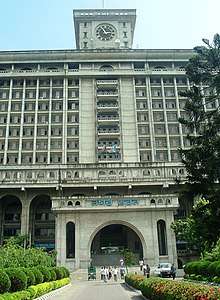
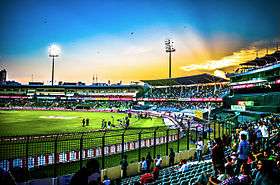
.jpg)
